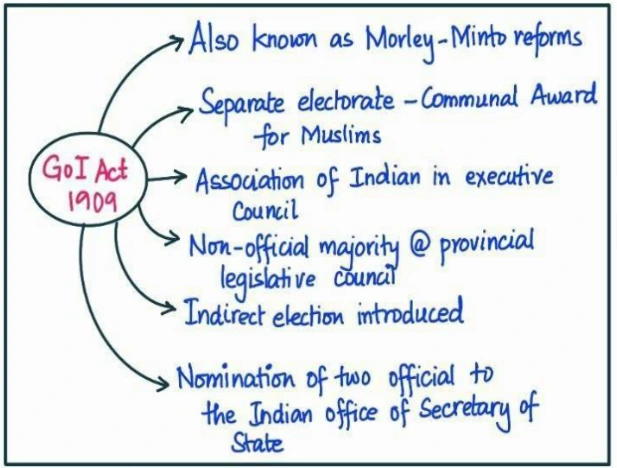Answer:
|
How to approach the question
- Introduction
- Write briefly about the Government of India Act 1909
- Body
- Write about the unique features of Government of India Act 1909.
- Write about the beginning of communalism with the Act.
- Conclusion
- Give appropriate conclusion in this regard.
|
Introduction
The Government of India Act of 1909, also known as the Morley-Minto Reforms, was an important legislative enactment during the colonial era in British India. It introduced significant changes to the legislative and administrative structures, as well as the electoral system.
Body
Unique features of Government of India Act 1909

- Introduction of Separate Electorates: The Act provided for separate electorates for Muslims, allowing them to elect their own representatives.
- Expansion of Legislative Councils: The Act expanded the size of the legislative councils and introduced indirect elections.
- Association of Indians: It provided for the association of Indians with the executive Councils of the Viceroy and Governors. Satyendra Prasad Sinha became the first Indian to join the Viceroy’s Executive Council.
- Non-official majority: It retained official majority in the Central Legislative Council but allowed the provincial legislative councils to have non-official majority.
- Nomination of two Indians: It allowed for the nomination of two Indians to the Indian office of Secretary of State.
- Discussion on Budget: The members could discuss the budget and move resolutions. They could also discuss matters of public interest. They could also ask supplementary questions.
Beginning of communalism with GoI Act, 1909:
- Seeds of Hindu-Muslim Divide: The Act contributed to the growing Hindu-Muslim divide by institutionalizing separate electorates after the Partition of Bengal in 1905, which intensified religious tensions.
- Increased Communal Consciousness: Separate electorates led Muslims, Hindus, and other groups to perceive their interests and rights as distinct from one another.
- Encouraged Communal Organizations: Success of All India Muslim League (AIML) in securing communal interest encouraged other communal organisations.
- Emergence of Polarizing Politics: For example, the Khilafat Movement, led by Muslim leaders, sought to rally Muslims against British colonial rule by appealing to their religious sentiments.
- Undermining National Unity: The Act undermined the idea of a unified Indian nation and instead reinforced muslims as a separate community, ultimately leading to the partition of the country.
Conclusion
Overall, while the Government of India Act 1909 expanded Indian participation in governance. However it reinforced communal divisions by introducing separate electorates based on religion, setting the stage for future conflicts between religious communities.
To get PDF version, Please click on "Print PDF" button.


Latest Comments